A camera for hiking is not just a luxury, it’s a necessity. It allows you to capture the beauty of nature and preserve those memories for a lifetime. So, if you’re planning a backpacking trip, make sure to invest in a good DSLR, mirrorless, or point-and-shoot camera.
1. Sony α7R IV: The Best Camera For Hiking
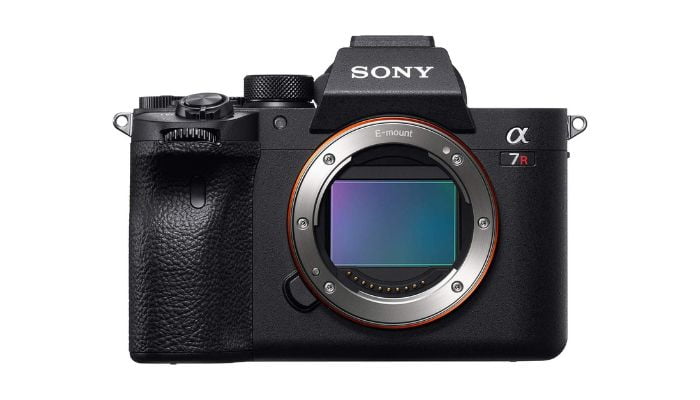
Specifications
- Type: Mirrorless
- Megapixels: 61MP
- Continuous Shooting Speed: 10 fps
- Weather Sealing: Yes
One of the main strengths of this hiking camera is its excellent resolution. With a full-frame 61-megapixel sensor, you can expect sharp, high-resolution images with plenty of detail and depth of color. I was really impressed by the colors, which came out rich and vibrant without appearing overly saturated.
Another advantage of the Sony α7R IV is its fast lens, capable of shooting up to 10 frames per second in RAW mode with AF tracking. This is an excellent feature for fast-paced shooting, and I found it very useful when photographing wildlife.
The camera also has impressive battery life for its size, capable of capturing up to 670 shots on a single charge. It is also waterproof for use in rain and dust, which is essential when you’re out in the elements.
Pros
Cons
- High-resolution and fast lens
- Excellent image quality
- Powerful video function
- Creative image effects
- Automatic sensor cleaning may not work
2. Olympus OM-D E-M5 Mark III
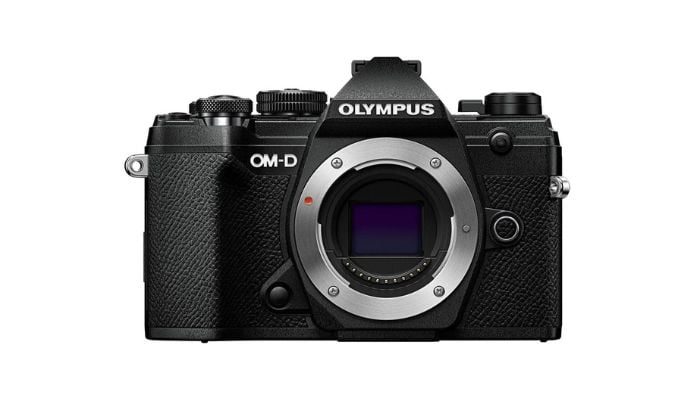
Specifications
- Type: Mirrorless
- Megapixels: 20MP
- Continuous Shooting Speed: 10 fps
- Weather Sealing: Yes
Well, as a photographer who has been working in the industry for some time now, I must say that the Olympus OM-D E-M5 Mark III is a quite decent camera for hiking. It’s lightweight, compact, and has quite impressive features that set it apart from other cameras in its category.
One of the main advantages of this Olympus camera is its size. It’s small enough to be easily carried during long hikes or camping trips without weighing you down.
Moreover, it boasts numerous features typically found only in larger, more expensive cameras. The six customizable buttons on the camera, along with the customizable button on the lens, make it very user-friendly and easy to navigate.
One of the drawbacks of this camera, however, is its shallow depth of field. This is due to its smaller Micro Four Thirds sensor, which is not as large as those found in full-frame cameras. This can limit the creative options available to photographers who prefer shallower depth of field.
Pros
Cons
- Small and easy to carry
- Simple controls
- Many scene options
- Quick autofocus
- shallow depth of field
- Not for professional photographers
3. GoPro HERO11
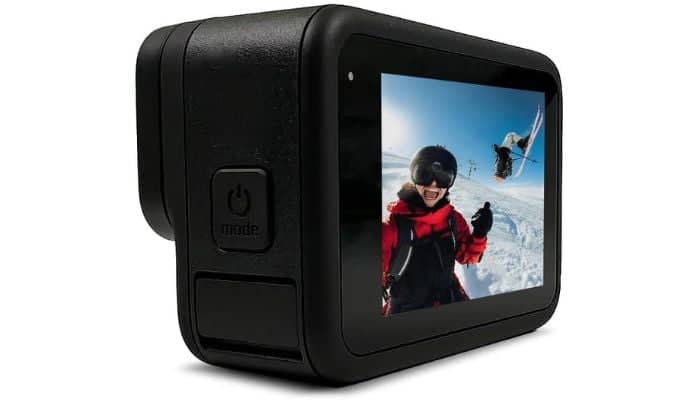
Specifications
- Type: Action
- Megapixels: 20MP
- Continuous Shooting Speed: 60 fps
- Weather Sealing: Yes
As a photographer with years of experience, I must say that the GoPro HERO11 camera is one of the best cameras for hiking. It’s incredibly lightweight, easy to use, and comes with a variety of features that make it an excellent choice for capturing some of the best moments of your adventures.
One of the main advantages of the GoPro HERO11 is its video stabilization. It’s one of the best stabilization systems I’ve seen on a camera this size, and it really helps to keep your footage smooth and stable even when you’re moving a lot. It’s also weather-resistant, so it can withstand tough conditions and protect your camera.
One of the biggest drawbacks of this GoPro camera is its battery life. The camera is known to drain batteries very quickly, so it’s a good idea to carry extra batteries or a spare battery if you plan to use the camera for extended periods.
Pros
Cons
- Great video stabilization
- Includes many accessories
- Sturdy build
- Simple to use as a webcam
- Battery drains quickly
- Extra batteries or battery packs may be needed
4. Panasonic LUMIX FZ2500
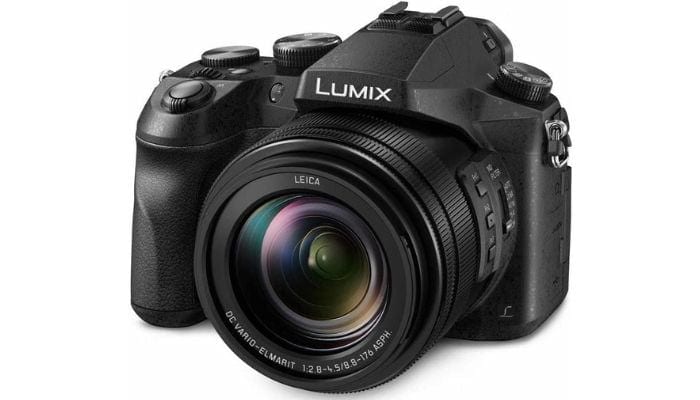
Specifications
- Type: Compact
- Megapixels: 20MP
- Continuous Shooting Speed: 30 fps
- Weather sealing: Yes
Firstly, this camera is a bridge camera with a powerful zoom, making it perfect for hiking. It’s packed with features to take your photography to the next level, including a touchscreen, headphone jack, Cinema 4K, longer zoom range, built-in ND filters, unlimited 4K recording, and 4K image stabilization.
One of the most remarkable features of this camping camera is its 1-inch 20-megapixel sensor, which provides higher resolution than typical super zooms. Additionally, it is paired with a bright f/2.8-4.5 Leica lens that offers an optical range of 480mm. This extensive optical range means the FZ2500 can produce sharp images even in low light conditions.
However, one of the drawbacks of this camera is its bulkiness. It’s not the lightest camera on the market, so it may not be the best choice if you plan to do a lot of walking or hiking during your adventure.
Pros
Cons
- Nice images even in low light
- Compatible with Panasonic’s image app
- 4K video recording
- Solid build quality
- large and heavy.
- No built-in GPS or Wi-Fi connectivity
5. Nikon D3500: For Beginners
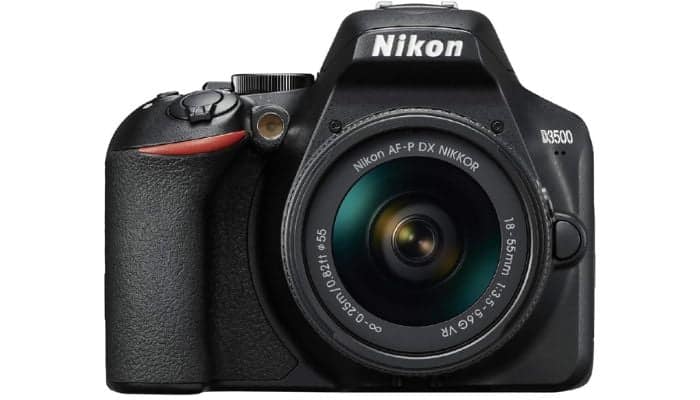
Specifications
- Type: DSLR
- Megapixels: 24MP
- Continuous Shooting Speed: 5 fps
- Weather Sealing: No
Nikon D3500 has a long battery life, which is essential when you’re out in nature for extended periods. It also features an APS-C sensor, which provides better image quality than other entry-level DSLRs. Its autofocus is also fast and accurate, which is crucial for shooting in low-light situations.
Another advantage of the D3500 is its “guide mode,” which can guide beginners through everything they need to know to start taking better photos. This feature is especially useful for those who are new to photography.
The camera also features a lag-free optical viewfinder, which is important for capturing the best possible shot every time.
However, the D3500 has a few limitations. This hiking camera lacks a touchscreen function, which can make adjusting settings on the fly a bit challenging. Moreover, it is not weather-sealed, meaning it may not be suitable for use in rainy or humid climates.
Pros
Cons
- Durable and long-lasting battery
- Good image quality
- Intuitive controls
- Excellent autofocus
- Not waterproof
- Lack of touchscreen
6. Fujifilm X-T30 II: Fast Autofocus System

Specifications
- Type: Mirrorless
- Megapixels: 26MP
- Continuous Shooting Speed: 8 fps
- Weather Sealing: No
One of the main advantages of this Fuji camera is its image quality. It features a 26-megapixel APS-C sensor that provides excellent details and vibrant colors.
As one of the best cameras for hiking, it also features a wide dynamic range, which is crucial for capturing landscape scenes with high contrast. The X-T30 II can shoot in Full HD and 4K resolution, making it ideal for creating high-quality video content as well.
However, there are a few drawbacks to this camera. One of them is its battery life, which can be a bit short when shooting in burst mode or recording video. It also takes some time to write files to the memory card, which can be frustrating when trying to capture a lot of photos in a short amount of time.
Pros
Cons
- Small and portable
- Captures 4K videos and RAW format
- Works with various lenses
- Offers a good dynamic range
- Lacks in-body image stabilization
- Battery life is limited
- The grip may not be as comfortable as other models
7. Panasonic Lumix ZS70
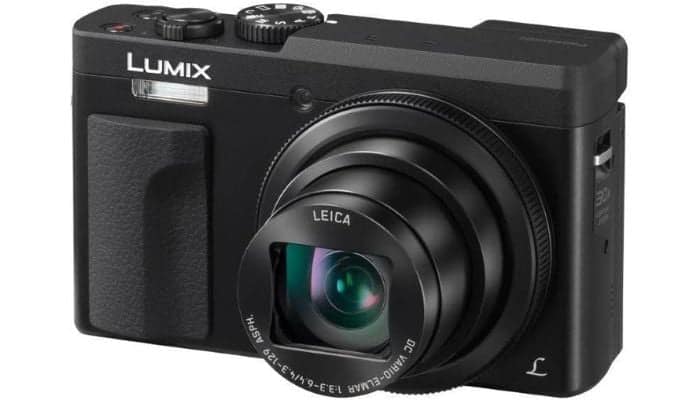
Specifications
- Type: Compact
- Megapixels: 20MP
- Continuous Shooting Speed: 10 fps
- Weather Sealing: Yes
First of all, I must say that this camera is an excellent choice for most people’s needs. It’s an advanced compact camera with a large optical zoom, excellent image quality, and comprehensive manual controls.
One of the main features of this camera is its small size, making it easy to carry during your travels. The battery life is also impressive, so you won’t have to worry about constantly recharging it.
The Lumix ZS70 also boasts impressive Wi-Fi capabilities and 4K video recording, which is fantastic for capturing high-quality images. It’s also great for taking photos in low light, thanks to its fast AF system and adjustable ISO settings.
However, the Panasonic Lumix ZS70 has some drawbacks. Its small sensor and average maximum aperture mean it struggles to capture exceptional still images when there is a lot of light around. While it is great for shooting 4K video, it is not the most sophisticated camera for hiking on the market when it comes to professional-level work.
Pros
Cons
- Excellent zoom range and image quality
- Good battery life and Wi-Fi capabilities
- Built-in body image stabilization
- Fast AF system
- Small sensor and average maximum aperture
- The lens may not be suitable for capturing distant or poorly lit subjects
8. Canon PowerShot G7X Mark III: Good Battery Life
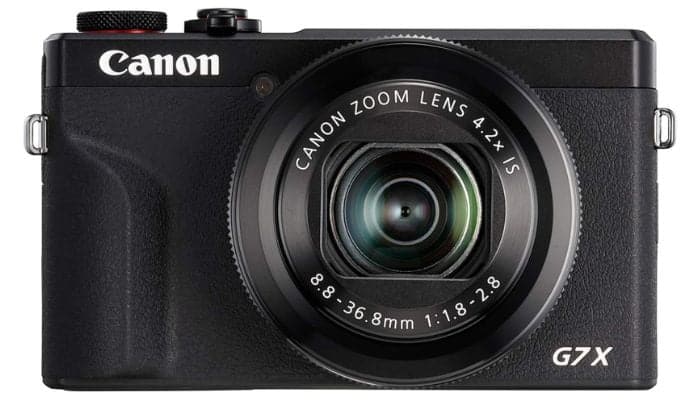
Specifications
- Type: Compact
- Megapixels: 20MP
- Continuous Shooting Speed: 30 fps
- Weather Sealing: No
First, I must say that this Canon camera is an excellent choice for backpackers seeking a compact camera capable of producing high-quality images. The camera’s touchscreen is also an interesting feature, making remote camera control and quick selfie-taking easier.
The wide ISO range of the camera and the ability to shoot in RAW or JPEG formats make it an excellent choice for photographers looking to experiment with their shots. The automatic ND filter is also a fantastic feature for nighttime photography.
One of the main issues with this hiking camera is the slight delay between pressing the button and the camera actually taking the shot. This can be frustrating for photographers who are not used to using a touchscreen.
Pros
Cons
- Excellent image quality
- Touchscreen for easy control
- Built-in Wi-Fi and NFC
- USB charging for added convenience
- No 4K video support
- Softness in the corners at 24 mm focal length
9. DJI Pocket 2: Has A Built-In Microphone
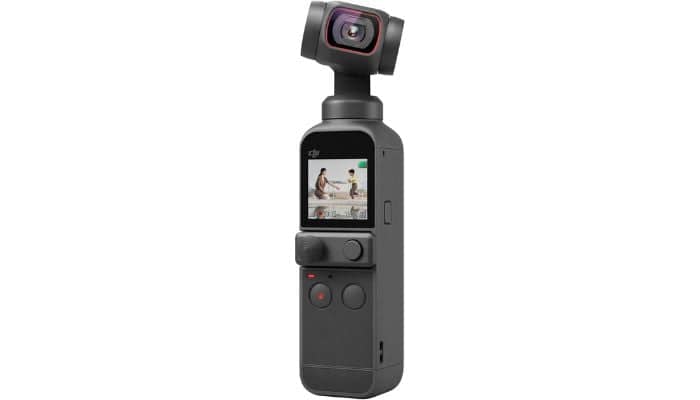
Specifications
- Type: Action
- Megapixels: 60MP
- Continuous Shooting Speed: 30 fps
- Weather Sealing: Yes
First of all, I must say that this hiking camera is an excellent choice for those who love capturing their travel experiences on the go. It’s compact, lightweight, easy to use, and has everything you need to record high-quality videos and photos.
One of the main advantages of the DJI Pocket 2 is its 3-axis stabilized gimbal, which helps reduce camera shake when recording sequences. This feature is particularly useful when walking or moving, as it smooths out much of the motion.
However, there are a few drawbacks to this GoPro alternative. One of the main issues is that it can be difficult to connect your phone to the camera, which is necessary to activate the DJI Mimo app. This can be frustrating and time-consuming, especially when you’re trying to capture a moment quickly.
Pros
Cons
- 3-axis stabilized gimbal for smooth footage
- High-quality video and photo capabilities
- Easy to use with various shooting modes
- Connects easily to smartphones
- Requires connection to a smartphone for using the DJI Mimo app
- Significant cropping in HDR video shooting may be an issue
- Small screen
10. Sony a6400: Wide Range of Lenses
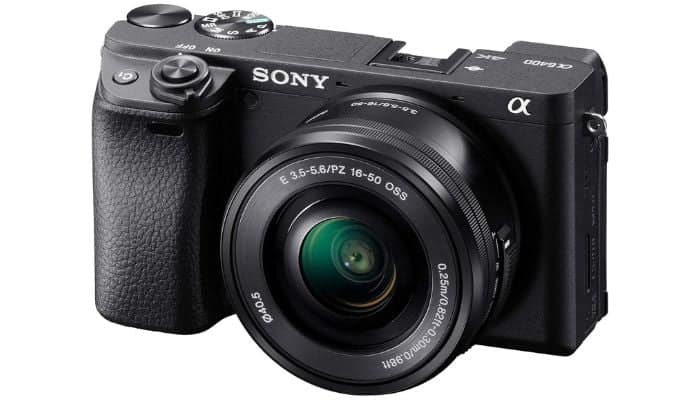
Specifications
- Type: Mirrorless
- Megapixels: 25MP
- Continuous Shooting Speed: 11 fps
- Weather Sealing: Yes
As a photographer who has spent countless hours hiking and capturing the beauty of the great outdoors, I must say that the Sony a6400 is a fantastic camera for hiking. It is lightweight and easy to use, making it the ideal camera to take on your travels.
One of the main strengths of the Sony a6400 is its autofocus system, which is both fast and precise. It offers a wide range of lenses, making it easy to find the perfect lens for every situation.
One of the main drawbacks of this mirrorless camera for traveling is its battery life. It’s not very long, and it can be annoying to change batteries when you’re hiking or camping overnight. However, this issue can be easily solved by carrying a spare battery.
Pros
Cons
- Lightweight and easy to use
- Provides high-quality images and videos
- Ideal for taking photos in low light
- Capable of recording time-lapse and focus-shift videos
- Battery life is not very long
- No built-in image stabilization
11. Olympus Tough TG-6: Robust And Durable
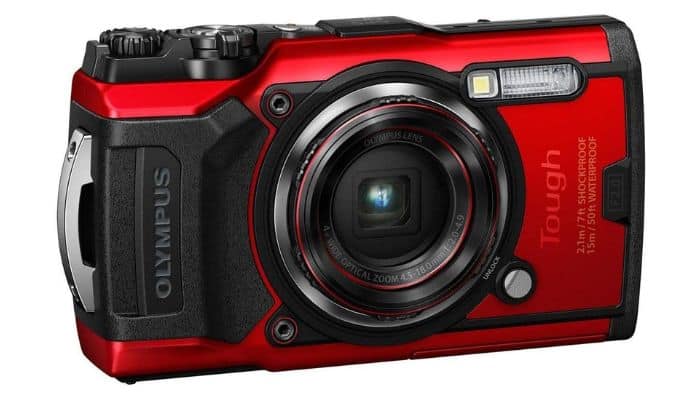
Specifications
- Type: compact
- Megapixels: 12MP
- Continuous Shooting Speed: 20 fps
- Weatherproof: Yes
The Olympus Tough TG-6 is a rugged camera that can handle the toughest conditions and continue to take photos even when dirty or in the midst of a storm. It is waterproof up to 50 feet and dustproof, making it perfect for outdoor adventures.
This camping camera features a high-speed back-illuminated CMOS sensor and a powerful TruePic VIII image processor, delivering rich and accurate colors. It also boasts a versatile range of camera modes, making it highly adaptable for various different situations.
However, this camera also has some disadvantages. The battery life of the TG-6 is not as long as I would like. It has a capacity of up to 340.0 shots, which is quite satisfactory and is CIPA certified. However, during repeated recordings at the maximum duration of 29 minutes, the battery life becomes limited.
Pros
Cons
- Easy portability
- High-speed CMOS sensor
- Versatile shooting modes
- Variable macro system
- Limited zoom range compared to other cameras
- No built-in viewfinder
- Battery life could be longer for extended trips
12. Sony ZV-1: For Vlogging
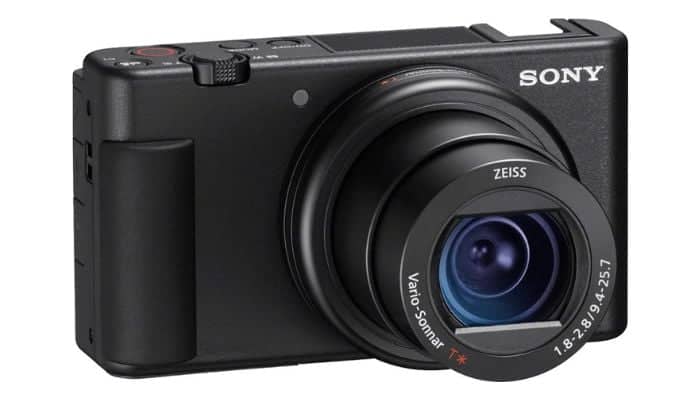
Specifications
- Type: compact
- Megapixels: 20MP
- Continuous Shooting Speed: 24 fps
- Weather Sealing: No
Despite its size, it makes no compromises on image quality. In fact, the ZV-1 offers excellent image quality and color science, especially when shooting in RAW. The autofocus system is also top-notch and can easily handle 4K video.
One of the remarkable features of this vlogging camera is its ability to shoot slow-motion images at 960 fps. It’s fantastic for capturing those moments of motion in nature, like waterfalls or moving animals. The audio quality is also good, with a built-in microphone that can capture voices well, especially in group settings.
However, this hiking camera has a few drawbacks. As you increase the ISO, the photos become less sharp and more noisy, so it’s not ideal for low-light situations. Furthermore, while the built-in microphone is good, it doesn’t replace an external microphone if you want to add background music or if the speaker is a few meters away from the camera.
Pros
Cons
- Excellent image quality when shooting in RAW
- Good video quality up to 4K resolution
- Capable of shooting slow-motion images at 960 fps
- Manual mode available
- Photos become less sharp and more noisy at higher ISO values
- Built-in microphone does not replace an external microphone
- Manual mode can be more complex
